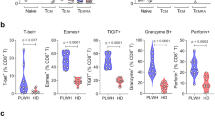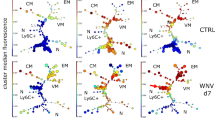Abstract
Cytotoxic T lymphocytes (CTLs) are thought to detect viral infections by monitoring the surface of all cells for the presence of viral peptides bound to major histocompatibility complex (MHC) class I molecules. In most cells, peptides presented by MHC class I molecules are derived exclusively from proteins synthesized by the antigen-bearing cells1. Macrophages and dendritic cells also have an alternative MHC class I pathway that can present peptides derived from extracellular antigens; however, the physiological role of this process is unclear2. Here we show that virally infected non-haematopoietic cells are unable to stimulate primary CTL-mediated immunity directly. Instead, bone-marrow-derived cells are required as antigen-presenting cells (APCs) to initiate anti-viral CTL responses. In these APCs, the alternative (exogenous) MHC class I pathway is the obligatory mechanism for the initiation of CTL responses to viruses that infect only non-haematopoietic cells.
This is a preview of subscription content, access via your institution
Access options
Subscribe to this journal
Receive 51 print issues and online access
$199.00 per year
only $3.90 per issue
Buy this article
- Purchase on Springer Link
- Instant access to full article PDF
Prices may be subject to local taxes which are calculated during checkout




Similar content being viewed by others
References
York, I. A. & Rock, K. L. Antigen processing and presentation by the class I major histocompatibility complex. Annu. Rev. Immunol. 14, 369–396 (1996).
Rock, K. L. Anew foreign policy: MHC class I molecules monitor the outside world. Immunol. Today 17, 131–137 (1996).
Van Kaer, L., Ashton-Rickardt, P. G., Ploegh, H. L. & Tonegawa, S. TAP1 mutant mice are deficient in antigen presentation, surface class I molecules, and CD4-8+ T cells. Cell 71, 1205–1214 (1992).
Huang, A. Y., Bruce, A. T., Pardoll, D. M. & Levitsky, H. I. In vivo cross-priming of MHC class I-restricted antigens requires the TAP transporter. Immunity 4, 349–355 (1996).
Restifo, N. P.et al. Antigen processing in vivo and the elicitation of primary CTL responses. J. Immunol. 154, 4414–4422 (1995).
Rotzschke, O.et al. Exact prediction of a natural T cell epitope. Eur. J. Immunol. 21, 2891–2894 (1991).
Lee, M. S.et al. Molecular attenuation of vaccinia virus: mutant generation and animal characterization. J. Virol. 66, 2617–2630 (1992).
Taylor, G., Stott, E. J., Wertz, G. & Ball, A. Comparison of the virulence of wild-type thymidine kinase (tk)-deficient and tk+ phenotypes of vaccinia virus recombinants after intranasal inoculation of mice. J. Gen. Virol. 72, 125–130 (1991).
Buller, R. M., Smith, G. L., Cremer, K., Notkins, A. L. & Moss, B. Decreased virulence of recombinant vaccinia virus expresison vectors is associated with a thymidine kinase-negative phenotype. Nature 317, 813–815 (1985).
Kundig, T. M.et al. Fibroblasts as efficient antigen-presenting cells in lymphoid organs. Science 268, 1343–1347 (1995).
Zinkernagel, R. M., Kreeb, G. & Althage, A. Lymphohemopoietic origin of the immunogenic, virus-antigen-presenting cells triggering anti-viral T-cell responses. Clin. Immunol. Immunopathol. 15, 565–576 (1980).
Bevan, M. J. Minor H antigens introduced on H-2 different stimulating cells crossreact at the cytotoxic T cell level during in vivo priming. J. Immunol. 117, 2233–2238 (1976).
Ren, R. B., Costantini, F., Gorgacz, E. J., Lee, J. J. & Racaniello, V. R. Transgenic mice expressing a human poliovirus receptor: a new model for poliomyelitis. Cell 63, 353–362 (1990).
Mandl, S., Sigal, L. J., Rock, K. L. & Andino, R. Poliovirus vaccine vectors elicit antigen-specific cytotoxic T cells and protect mice against lethal challenge with malignant melanoma cells expressing a model antigen. Proc. Natl Acad. Sci. USA 95, 8216–8221 (1998).
Ren, R. & Racaniello, V. R. Human poliovirus receptor gene expression and poliovirus tissue tropism in transgenic mice. J. Virol. 66, 296–304 (1992).
Bevan, M. J. Cross-priming for a secondary cytotoxic response to minor H antigens with H-2 congenic cells which do not cross-react in the cytotoxic assay. J. Exp. Med. 143, 1283–1288 (1976).
Kovacsovics-Bankowski, M., Clark, K., Benacerraf, B. & Rock, K. L. Efficient major histocompatibility complex class I presentation of exogenous antigen upon phagocytosis by macrophages. Proc. Natl Acad. Sci. USA 90, 4942–4946 (1993).
Kurts, C., Kosaka, H., Carbone, F. R., Miller, J. F. & Heath, W. R. Class I-restricted cross-presentation of exogenous self-antigens leads to deletion of autoreactive CD8(+) T cells. J. Exp. Med. 186, 239–245 (1997).
Kurts, C.et al. Constitutive class I-restricted exogenous presentation of self antigens in vivo. J. Exp. Med. 184, 923–930 (1996).
Reis e Sousa, C. & Germain, R. N. Major histocompatibility complex class I presentation of peptides derived from soluble exogenous antigen by a subset of cells engaged in phagocytosis. J. Exp. Med. 182, 841–851 (1995).
Rock, K. L. & Clark, K. Analysis of the role of MHC class II presentation in the stimulation of cytotoxic T lymphocytes by antigens targeted into the exogenous antigen–MHC class I presentation pathway. J. Immunol. 156, 3721–3726 (1996).
Albert, M. L., Sauter, B. & Bhardwaj, N. Dendritic cells acquire antigen from apoptotic cells and induce class I-restricted CTLs. Nature 392, 86–89 (1998).
Shen, Z., Reznikoff, G., Dranoff, G. & Rock, K. L. Cloned dendritic cells can present exogenous antigens on both MHC class I and class II molecules. J. Immunol. 158, 2723–2730 (1997).
Pfeifer, J. D.et al. Phagocytic processing of bacterial antigens for class I MHC presentation to T cells. Nature 361, 359–362 (1993).
Bachmann, M. F.et al. TAP1-independent loading of class I molecules by exogenous viral proteins. Eur. J. Immunol. 25, 1739–1743 (1995).
Kovacsovics-Bankowski, M. & Rock, K. L. Aphagosome-to-cytosol pathway for exogenous antigens presented on MHC class I molecules. Science 267, 243–253 (1995).
Ploegh, H. L. Viral strategies of immune evasion. Science 280, 248–253 (1998).
Sigal, L. J., Reiser, H. & Rock, K. L. The role of B7-1 and B7-2 costimulation for the generation of CTL responses in vivo. J. Immunol. 161, 2740–2745 (1998).
Moore, M. W., Carbone, F. R. & Bevan, M. J. Introduction of soluble protein into the class I pathway of antigen processing and presentation. Cell 54, 777–785 (1988).
Acknowledgements
We thank R. O. Donis and the members of the Rock laboratory for helpful discussions; R. Welsh, L. Berg, G. Soldevila and N. Kisaiti for critical reading of the manuscript; W.Yong Zang and L. Rothstein for technical assistance; and M. Bevan for EG7 cells, P. Doherty for MC57G cells, and J. Yewdell for vaccinia-OVA and vaccinia SS-SIINFEKL. This work was supported by NIH grants to K.L.R. and R.A. L.J.S. was supported by an NIH Research Training Grant.
Author information
Authors and Affiliations
Corresponding author
Rights and permissions
About this article
Cite this article
Sigal, L., Crotty, S., Andino, R. et al. Cytotoxic T-cell immunity to virus-infected non-haematopoietic cells requires presentation of exogenous antigen. Nature 398, 77–80 (1999). https://doi.org/10.1038/18038
Received:
Accepted:
Issue Date:
DOI: https://doi.org/10.1038/18038
This article is cited by
-
The transcription factor Zeb1 controls homeostasis and function of type 1 conventional dendritic cells
Nature Communications (2023)
-
Coexistence of HLA and KIR ligand mismatches as a risk factor for viral infection early after cord blood transplantation
Bone Marrow Transplantation (2022)
-
TAP dysfunction in dendritic cells enables noncanonical cross-presentation for T cell priming
Nature Immunology (2021)
-
The roles of microglia in viral encephalitis: from sensome to therapeutic targeting
Cellular & Molecular Immunology (2021)
-
The receptor DNGR-1 signals for phagosomal rupture to promote cross-presentation of dead-cell-associated antigens
Nature Immunology (2021)
Comments
By submitting a comment you agree to abide by our Terms and Community Guidelines. If you find something abusive or that does not comply with our terms or guidelines please flag it as inappropriate.



